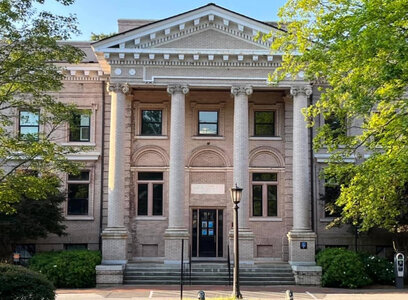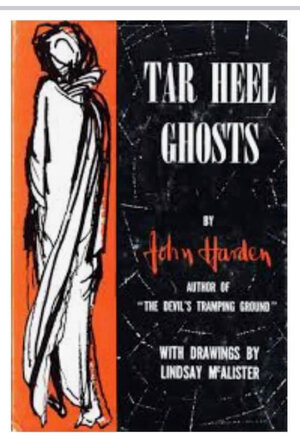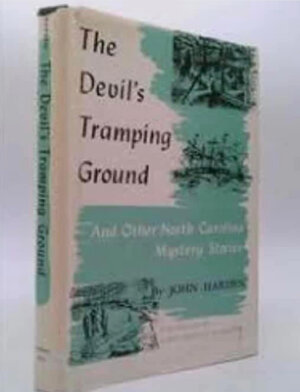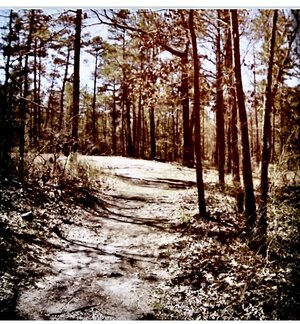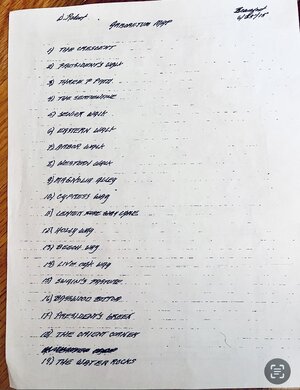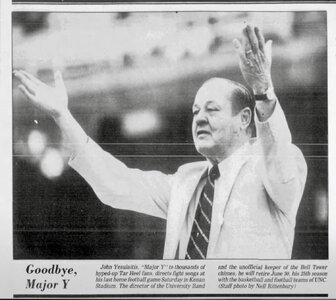I always thought Rob Ladd was much closer to my age (CHHS 1980) than Don Dixon’s age (I think of Don as being my neighbor’s age, Bland Simpson).Don Dixon (as it says in the title) with Parthenon Huxley (AKA Rick Rock) and on drums, Rob Ladd (of Pressure Boys/Red Clay Ramblers fame)
Navigation
Install the app
How to install the app on iOS
Follow along with the video below to see how to install our site as a web app on your home screen.
Note: This feature may not be available in some browsers.
More options
You are using an out of date browser. It may not display this or other websites correctly.
You should upgrade or use an alternative browser.
You should upgrade or use an alternative browser.
The Village People and The Bacchae - Chapel Hill, Carrboro, & UNC
- Thread starter donbosco
- Start date
- Replies: 884
- Views: 28K
- Off-Topic
donbosco
Inconceivable Member
- Messages
- 4,317
I always thought Rob Ladd was much closer to my age (CHHS 1980) than Don Dixon’s age (I think of Don as being my neighbor’s age, Bland Simpson).
That's about right on Rob's age...but he was a bit of a prodigy. This line-up, Dixon, Parthenon Huxley/Rick Rock/Rick Miller, and Rob Ladd is cross generational for sure with Dixon and Miller coming from more Arrogance times and Ladd coming along later. This clip is from 1985 though. Huxley soon moved to California and did a lot of session work then got on with Electric Light Orchestra II.
Huxley recently wrote a memoir.
Electric Light Odyssey: My Zigzag Life and the Iconic Band that Changed Everything: Huxley, Parthenon: 9798990848818: Amazon.com: Books
Electric Light Odyssey: My Zigzag Life and the Iconic Band that Changed Everything [Huxley, Parthenon] on Amazon.com. *FREE* shipping on qualifying offers. Electric Light Odyssey: My Zigzag Life and the Iconic Band that Changed Everything
www.amazon.com
Tell Bland that Hunter and Susannah's old childcare giver and her husband said hi.I always thought Rob Ladd was much closer to my age (CHHS 1980) than Don Dixon’s age (I think of Don as being my neighbor’s age, Bland Simpson).
donbosco
Inconceivable Member
- Messages
- 4,317
This one is from the heart.
Sometimes I manage a return to Chapel Hill — Those times are pilgrimages of a sort for me and I never see nearly even close to all of the people so dear to my heart in that timeless place. I love Chapel Hill/Carrboro and it holds magic for me in so many ways. I walk the streets, sidewalks, and brick pathways, and history, personal and public, swells up in my mind and soul of souls. I romanticize. Of that there is no doubt. I lived in Chapel Hill from 1976 to 1983 and then again from 1986 to 2009. It is my truest home and my heart is there in so many ways. In recent trips I have gone to campus at dawn with the dogs and I have taken joy in their eternal sense of exploration as we walked beneath the giant trees and across lawns that have been trod by so many infused with hope for 200+ years. They remind me of my own exuberant first days and weeks in August of 1976. Going back to the mind of Freshman-Me is itself renewing.
I am well aware that there are sordid chapters in my Alma Mater’s story though I admit that I was not always so enlightened. Events both distant in time and recent have been shameful and hurtful and have pained so very many. I am also glad, even grateful, for the great many positives that UNC has brought forth across time. Like a family member who strays yet remains beloved so too is Carolina for me.
These days the helm once captained by Frank Porter Graham and necessarily lesser folk but nevertheless well-intentioned educators has been captured by a gang uninterested in broadening but rather in narrowing ways of seeing…in making small what has most often been far-reaching. From afar I watch with great love and interest as thinkers and do-ers at my Alma Mater struggle - as they have done through other dark times when weak minds with a monopoly on force have worked to diminish the spirit of the place. I do fear this time that the darkness is stronger than in a very long time and that the struggle afore all who care is nigh Sisyphean - and cross-generational. Lux Libertas friends - we’re not in this alone. The fight is on North, South, East, and West - from Manteo to Murphy, Asheville to Atlantic Beach, and Boone to Beaufort. So too is the battle on state by state. The goal of the Darkness is to close the mind and kill the ideas. These days almost all of our colleges and universities are under attack. Alma Maters bend under the weight of misrepresentation born of a not-unfamiliar ill-will. Creativity, imagination, and hard work has never been more needed for this battle is essentially one of Truth-David fending off The Propaganda-Goliath. May 1 Samuel Inspire and serve as blueprint in these times of challenge.
The photo below is of Bynum Hall, originally the home gymnasium for Tar Heel men’s Basketball. Between 1910 and 1924 UNC WAS 61-15 in this building. So a precedent of success at that most beautiful game was set right there. Bynum was where you paid bills during my time at Carolina and ultimately where I submitted the final copy of my dissertation in 1999. That last function was far more tense than it ought to have been because the manuscript had to pass inspection by the Office of the Secretary of the Graduate School located there, who was not the least bit interested in content but rather proper margins, headers, and footers — any of which we were warned, if improperly rendered were bound to stall the doctorate in its tracks. For a time the Journalism Department lived in Bynum and plenty still remember the University Cashier office there. Today there is a fountain in front but when I was an undergrad that spot was occupied by a very simple volleyball court at which every Friday afternoon scholars met and very informal games were played. Bynum Hall is a bit of a microcosm of Carolina if you know the history of the place. It helps I guess to have lived some of it too. May Light Prevail Over The Current Darkness. Lux Libertas.

Cool off at Fordham Fountain | UNC-Chapel Hill
An oasis in Bynum Circle, with 1995's Fordham Fountain at its heart, provides seating, shade and a cooling spray.
Wasn’t Hunter and Susannah’s childcare giver Nicole……Tell Bland that Hunter and Susannah's old childcare giver and her husband said hi.
Not in preschool. This was at Sue Ann Court.Wasn’t Hunter and Susannah’s childcare giver Nicole……
donbosco
Inconceivable Member
- Messages
- 4,317

Finding Aids
Kemp Battle Nye would be a strong candidate for Mr. Chapel Hill.
Last edited:
I’ve only known Bland since 1995.Not in preschool. This was at Sue Ann Court.
donbosco
Inconceivable Member
- Messages
- 4,317
Simpson (I’ve only met him a couple of times very briefly) has a memoir out- Clover Garden.
Clover Garden
Clover Garden
donbosco
Inconceivable Member
- Messages
- 4,317
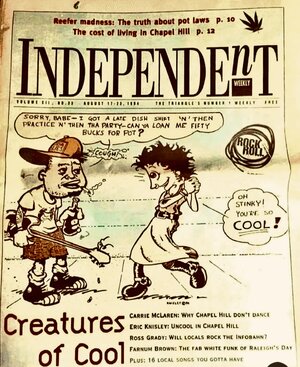
This Week 31 years ago. ‘Creatures of Cool” ’The Independent, August 17-23, 1994.’ (Art by Eric Knisley) hit the racks. The Indy’ was a very important paper back when papers were important (It still carries on as key resource). So too was ‘The Chapel Hill News’ once upon a time. ‘The News and Observer’ and ‘The Durham Herald’ also served The Triangle, in ever-shifting focuses on one niche after another. And of course, ‘The Daily Tar Heel’ brought campus free to Chapel Hillians and Carrboroites five days a week. Think back far enough and you’ll probably snatch some fond recollections of searching the “Help Wanted” and “For Rent” section of ‘The Village Advocate’ or of “The Spectator” and the battles it waged with ‘The Independent’ for newsweekly supremacy. And lest we forget, ‘The Triangle Comic Review’ fostered wry smiles, actual “Laughter Out Loud,” and refrigerator door post-ups nigh every week. ‘The Anvil’ and ‘The Community Sports News’ helped fill out our internal databases. Particularly keen ‘in those times’ was that our great and attentive chroniclers were our friends, neighbors, and soulmates.
I still buy a paper now and then but I seldom pick up the free ones that list upcoming events and SHOWS. I don’t go to a show five nights a week anymore. Clearly though, plenty of people do. I also don’t have a coffee shop that serves as my living room anymore either. Indeed, I no longer have a true “Third Place” in my life. (Home-Work-Third Place) Thankfully I do have a place or two where far, far from “everybody knows my name” but at least a few do.
Those newspapers were once strewn pell mell across the bar and nearby tables at The Hardback Cafe and Bookstore. I no longer see such a scene anywhere I go. Who bought the pages that daily comprised those random piles of stories and editorials and photographs and cartoons and critiques and crosswords anyway? I guess we all chipped in. Jim Smith wrote us a theme song: “We all read the local paper, we all read the New York Times, but the comics and the crosswords seem to monopolize our time. We make a team sport out of moral support so we all seem to do quite well. As long as we have some faith in ourselves then the world can go to hell. And we leave our ambition at the door around here. We like it best that way. We always find a friend in here — at the Hardback Cafe.” = Theme Song.
This is not a lamentation by the way - times have changed - as they do. I get plenty of news still. And my life and lifestyle have altered over time along with my location(s). I’d have to slow down considerably if I were to even cultivate a “Third Place” these days and even then it would likely be odd — and convincing the rest of the world to join in with me would also be a monumental ask. I know some of you still have a semblance of such a thing regularly in your lives and I number you among the luckiest on earth. Count your blessings both past and present.
And enveloping that setting steeped in print media was a scene or three. There was a lot of political apathy and thoughtlessness all around in those times. My ignorance — OUR ignorance — was deeper than we could even imagine on our best days. Understanding of race, gender, identity, rights, and privilege was still stuck in the 20th century. The measure of progress made is how well we now comprehend the distance we have yet to go. Also so clearly manifest today, only fuzzy back then, is the opposition to that very forward movement.
Still, one has to believe that having a “Third Place,” a spot into which we can drop in, stop by, grab a cup of coffee or a pint, and commiserate or reminisce or laugh, is a universal desire…perhaps even a need. If you’ve got it, rejoice. If you’ve had it, you are blessed. If you plan, or hope, to have it again, then may all the fortune of the world fall upon you. And when you’re in that “Third Place” and someone walks in - teleported from days gone by - do yourself a favor and herald them hale and hearty. It will lift us up every one.
donbosco
Inconceivable Member
- Messages
- 4,317
WeeeeHoooo!!!
North Carolina is haunted. It is mysterious. It was LOST from the very start of its Invasion History. Sandwiched between “The Mother of Presidents” and a bunch of “Fire-Eating Sandlappers” we (without the slightest irony) proudly claim both humility (To Be Rather Than To Seem) and a homegrown brand of working class stubbornness (Tar Heel is about sticking when others flee, see Bruce Baker’s definitive history of the term here: Project MUSE - Why North Carolinians Are Tar Heels: A New Explanation - Note that the author, a historian, found the term to predate the Civil War), but if newspaperman and author John Harden (1903-1985) is to be believed we might very well deserve the more modern handle, Ghostbusters.
John Harden is the author of two books that, as best I remember, graced the living room book shelves of every member of my mother’s large family and many others in Chatham: 1) ‘The Devil's Tramping Ground and Other North Carolina Mysteries,’ and 2) ‘Tar Heel Ghosts.’ I poured over those smallish reads as a boy and was particularly delighted that the first bore in its very title the name of a mysterious enough place just three miles from my house in #Bonlee, and situated in the Deepest of #DeepChatham — The Devil’s Tramping Ground. I’m not going to try and explain that place here. You can Google and library-search for hours on that but I will say two things about the spot. The first is that I often heard it said by the customers in #BonleeHardware that the place was much less ‘active’ than it once was because the Bad Man was so busy at present that he had little time, or need, for a place to pace and plot. And second, I’ve always suspected that moonshining had just a little something to do with the legend. That comes from my Deddy, who, as I have previously noted, knew about such things.
Those two little books were filled with tales of hoof prints in stone, disappearing hitchhikers, golden arms, and distant, sometimes moving, and unexplainable, lights. The Tramping Ground being so close by — I have visited many times. I’ve been a guide for a significant number of those forays and the telling of a scary story or two along the ride is mandatory. Once upon arriving with a car full of northern cousins as we piled out of my ‘75 Chevelle (The Gray Ghost I called her!) a skinny little dog appeared from the darkness and proceeded to silently lead us up the trail. That little guy then melted into that same darkness just as the wind came up and a loud rumble of summer thunder sent us all recklessly stumbling back down that same path, now laced by what seemed to be cross-trail roots that rose up to meet our feet. It was a glorious fright.
I often mention North Carolina’s Haunted History in class. I’m sad to report that those books don’t seem to be as popular as they once were. My students don’t know about ‘The Ghost of Maco Station” or “A Colonial Apparition” or “The Little Red Man.” I’m not saying that spooky things and creatures are currently in short supply, after all the creators of one of the scariest horror stories of late, ‘Stranger Things,’ Matt and Ross Duffer are born and raised up Durhamites. Sadly for us, North Carolina’s recent unfriendliness toward the Arts and Entertainment meant that instant classic was filmed in Georgia (and set in Indiana) instead of This Haunted Land.
We began our so-called modern history with a mystery still unsolved - we are thus, still LOST in a way. Perhaps that is the essence of Esse Quam Videri - the great search for being - or, in turn, nothingness?
#OTD in 1590 John White returned to Roanoke Island and found CROATOAN carved in a post. The second sign, one of danger, a Maltese Cross, was not evident (I’ve always thought that they had that backwards. Two signs for safety, a single and most simple one for flight). He left out for England in 1587 for supplies but war with Spain and pirates prevented a quick return. The carving was a sign that the colony had moved. They were-sadly-LOST.

Origins of the “Lost Colony” Mystery
On August 18, 1590, Englishman John White returned to Roanoke Island to resupply the colony established on the island in 1587. White found the settlement abandoned. A single word “CROATOAN” was carved on a post in the fort.www.ncdcr.gov
Scary stuff!
donbosco
Inconceivable Member
- Messages
- 4,317
A UNC graduate's full-ride scholarship was suspended after he joined a protest 50 years ago. Now, he fears history is repeating itself.
"We compared our letters — our suspension letters, the letters that we sent to try and keep our scholarship," Forero told WUNC in April. "And it's incredible how similar the language is over 50 years later."
A UNC graduate's full-ride scholarship was suspended after he joined a protest 50 years ago. Now, he fears history is repeating itself. - NewsBreak
Frank Alexander hadn't thought of the cardboard box stashed away in his closet in almost 50 years. The simple gray container holds dozens of records from h
donbosco
Inconceivable Member
- Messages
- 4,317
The Zigga Zoomba Man in my experience.
donbosco
Inconceivable Member
- Messages
- 4,317
The Mills of Carrboro – 32 Years Apart
http://dc.lib.unc.edu/u?/ncmaps,7006Today’s assignment is to compare and contrast. The images above are portions of fire insurance maps depicting Carrboro. The top one is a 1915 map produced by the Sanborn Fire Insurance Company. The other is a 1947 map produced by Associated Factory Mutual Fire Insurance Companies. The full maps are included on North Carolina Maps. As you might image, Carrboro changed a little between 1915 and 1947. What’s the same? And what’s different?
Here are a few facts we already know. The 1915 map depicts the facilities of Durham Hosiery Mills, a textile manufacturing company started by Julian Carr in the early days of the 20th century. Those same factories were owned in 1947 by Pacific Mills, a Lawrence, Massachusetts-based textile manufacturer. Pacific Mills bought the buildings and property in 1945, by which point textile manufacturing in Carrboro had ceased. The re-opened mills provided jobs for about 550 people and they produced worsted wool. But the revival of textile manufacturing in Carrboro was short-lived. By 1955 Pacific Mills had closed its plants there.
The Sanborn Fire Insurance map is among many in our collection. The map produced by Associated Factory Mutual hangs in the Carrboro town offices. The folks there allowed us to scan it and share it with the wider world. We’re honored to do so. And we hope that you can tell us how the Paris of the Piedmont changed between 1915 and 1947. And, while you’re at it, feel free to tell us how the depictions compare with what you see today.
donbosco
Inconceivable Member
- Messages
- 4,317
Town Hall: The Downtown Blues
By Sy Safransky•October 1976I’m probably the wrong one to eulogize Town Hall. Someone with a taste for the crowds and the suds should be sweeping the ashes, humming all the while. Town Hall was its own universe, the collective creation of its own boozy imagination, a huge cave echoing sweets and horrors. Dark, raunchy, bizarre, it was a choice booking for bands but was also the club with one of the worst reputations for violence. And what a smell! — a music all its own, harmonies of sweat and fright and hustle, stale beer and smoke, an armpit only a drunk could love. If, during the day, it was the best place to buy a sandwich, one could think of better places to eat it.
Still, there was a raw kind of exaltation about it. It was as public an environment as one could imagine. And so, the best and the worst of a university town found its way there. Whether they came because they loved it, or were curious, or lonely, or simply thirsty, they found something in the ruins. Beat, hip, black, white, bullshitters of every ilk, they were a family, all right, and smack in the middle of Chapel Hill. Could the symbolism be more overt?
Four years ago, when Dave Bratten was talking about opening Town Hall, what he had in mind was more than another beer joint. It was to be what its name suggested — a place for political meetings, a focal point for the community: the craftspeople and poets and musicians and dreamers that make Chapel Hill what it is. Dave was a visionary (his other dream, New Eden, conceived as a planned, self-sufficient community in the country, lured me here in the first place) and full of seeming contradictions. Gentle, but stubborn, he was a traditionalist who resented authority, a deeply religious man who carried his Bible, discreetly, from The New Establishment, the bar he owned at the time, across the street to the new Town Hall. For a while, he called himself a Christian Democrat, which has a strange ring to American ears. But Town Hall was as American a dream as they come.
New Eden is a trailer park now. Town Hall has folded. It’s been resurrected as Cenergy, a “New Age” club, essentially gay, and open to members only. The wheel has turned again — 180 degrees, to be exact — and whether we chalk it up to the cosmic play of opposites, or the ruder social yin and yang of scheme and vision, crap and quality, the result is, depressingly enough, the same.
Town Hall had only been in business a couple of years when Dave sold his shares and left Chapel Hill, to attempt New Eden elsewhere. His partner, Mike Strong, carried on against mounting odds: the break-up of the bands that drew the largest crowds, Town Hall’s increasingly unsavory reputation, bad management. And now that Town Hall has finally expired, the bird that rises from the ashes soars heavenward for members only, Saturday if you’re gay. But why a private club in the middle of Chapel Hill? What does this tell us about ourselves, midway through the seventies, at the dawn of our third American century?
The answer to the first question seems obvious: money. Indeed, Cenergy charges more to dance to records than some bars charge for live bands. But it’s only half an answer. Those who view every “uptown” business venture as motivated solely by greed are often the same people who idealize “alternative” businesses. They miss the point. They confuse substance with form — our generational error; our human error since we dropped from the trees — and so a young man with long hair selling brown rice is assumed to be more worthy than an elderly woman selling pantyhose. This is properly, the subject of another essay. The point is that money, itself, is neutral: it can’t be anymore blamed for the uses to which it’s put than bricks can be blamed for split-level houses. To chalk up Town Hall’s demise to a greedy landlord, or Cenergy’s arrival to a businessman’s appetite, is to weave a strand of social truth into a web of illusion. Let the economic determinists — when they’ve finally figured out what happened in Russia, and what’s about to happen in China — come up with a better answer. To me, society is a mirror, and the face we see is a reflection of our own psychic blemishes, worry-lines, suspicions.
Yet, with Dave Bratten’s high ideals in mind, we ask, with William Irwin Thompson, in his new book, Evil and World Order: “How is it that when we try to do good we can often end up by creating greater evil? The Declaration of the Rights of Man in 1789 ended in the Reign of Terror and the rise of the dictatorship of Napoleon. The temporary dictatorship of the proletariat in Russia ended up in the permanent dictatorship of the ex-proletariat in the new bourgeoisie of the Communist Party. America fought a revolutionary war against the British empire, and then became an empire fighting to suppress a guerrilla war of national liberation in Vietnam.” Town Hall becomes a private club with different cards for gays, bis, and straights. Are there mirrors in Cenergy? Shall we study our faces? The Village Advocate gushes that Chapel Hill’s West Side is an exciting place to shop. What Whitmanesque adoration! No lines does the Advocate draw between grains and nylons. At Aurora, the West Side’s new “in” place to eat, there are mirrors aplenty, and a decor to evoke the Forties; what fabulous years: I recall Hiroshima ’45.
The Woodstock generation turns in its sleep. The Woodstock mud is dust on the mirror, and on the road. One for the road, then, and to dust, returned. Thompson: “Unless the Good is seen shining in the immediacy of the act, it should not be adopted. All appeals to reason, expediency, and necessity are appeals to the very forces that wreck all ideals. One must have courage and be willing to take risks; no one can love who has not known his own terror; that is what the temptation, the crucifixion, and the resurrection of Christ are all about.”
A private club in the middle of Chapel Hill tells us about nothing so much as our own private hearts, for members only. It is our cross to bear: let each of us decide why, and passing Cenergy’s windows the next time stare directly through, and not just at, our reflection in the glass.
Since writing this, I learned that Cenergy was on the verge of bankruptcy. This I interpreted as a positive omen or the most frightening instance of instant karma Chapel Hill has known, or both. So I called Mike Strong, who filled me in. Briefly, Cenergy, underwritten by investors to whom Mike turned to bail himself out, was a flop. Nobody came: the gays alienated the straights, but even the gays didn’t turn out; Franklin Street was too public for the kind of crowd that made the old electric Company such a success. I’m still unclear about the precise relationship between Cenergy and Town Hall — since Mike was still, apparently, in charge — but it’s academic. “We’re out of business,” he said, “Dave thought if you treat people right, they’ll treat you right,” he went on. “It’s a nice philosophy but I don’t know that it works too well.” He said that some $25,000 in inventory was stolen every year by employees and customers, and suggested, “You need locks to keep honest.”
Business failures notwithstanding, I suspect Dave’s philosophy is much the same, except he might put it: Love thy neighbor as thyself. Our new Franklin Street neighbor, by the way, will probably be a mini-mall with boutiques or a discount drugstore. Mike thinks it’s unlikely there will be another bar there.
Sy Safransky
- Messages
- 1,500
The very first time I went to "Town Hall" was when some friends of mine, who had formed a band, "One Night Stand" IIRC, played there. "One Night Stand" also played in an upstairs bar, "The New E" IIRC, on the opposite side of Franklin Street. At the time, I thought the "Town Hall" was a big step up from "The New E." That band disbanded a short time later.
Share:

